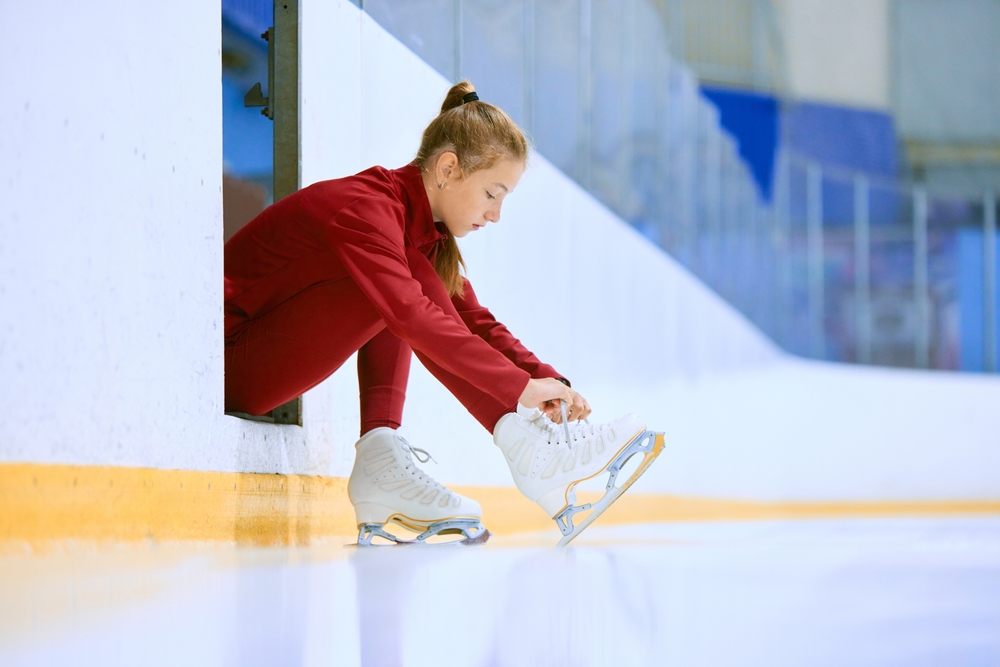Synchronized Ice Skating: The Ultimate Team Sport on Frozen Water
Gliding across the ice in perfect unison, sixteen skaters move as one, creating intricate formations and executing complex maneuvers with breathtaking precision. This is synchronized ice skating, a captivating blend of artistry, athleticism, and teamwork that pushes the boundaries of what's possible on frozen water. As the fastest-growing discipline in figure skating, synchronized ice skating is redefining the sport and challenging perceptions of what it means to be a team athlete on ice.

As the concept gained popularity, more teams began to form across North America. The sport’s early development was largely influenced by drill team performances and military precision drills, with teams focusing on maintaining straight lines and executing perfectly timed movements. Throughout the 1970s and 1980s, synchronized skating evolved from a novelty act to a serious competitive discipline, with teams pushing the boundaries of creativity and technical difficulty.
The International Skating Union (ISU) officially recognized synchronized skating as a discipline in 1994, paving the way for international competitions and standardized judging criteria. The first World Synchronized Skating Championships were held in 2000 in Minneapolis, Minnesota, marking a significant milestone in the sport’s history and solidifying its place in the global figure skating community.
The Anatomy of a Synchronized Ice Skating Team
A standard synchronized ice skating team consists of sixteen skaters, though some divisions allow for larger or smaller team sizes. The composition of a team is crucial to its success, as each skater must possess a unique blend of individual skill and the ability to work seamlessly within the group.
Synchronized skating demands a diverse range of abilities from its participants. Skaters must have strong fundamental figure skating skills, including edge control, speed, and power. However, unlike individual figure skating, synchronized skaters must also develop a keen spatial awareness and the ability to maintain perfect timing with their teammates.
Teams typically include skaters with varying strengths and body types. Taller skaters are often positioned at the ends of lines or in the center of formations to create visual interest, while shorter, more agile skaters may be utilized for quicker transitions or intricate footwork sequences. The key to a successful team lies in leveraging each skater’s strengths to create a cohesive and dynamic performance.
Leadership roles within the team are crucial. Many teams designate a captain or co-captains who help coordinate practices, communicate with coaches, and provide on-ice direction during performances. These leaders must possess not only exceptional skating skills but also strong communication and motivational abilities to keep the team focused and united.
The Technical Marvels of Synchronized Skating
Synchronized ice skating programs are a mesmerizing display of precision and creativity, combining elements from various figure skating disciplines with unique synchronized movements. Teams perform two programs in competition: a short program lasting about 2 minutes and 50 seconds, and a free skate lasting approximately 4 minutes and 30 seconds.
One of the most distinctive features of synchronized skating is the array of complex formations teams create on the ice. These include lines, circles, wheels, blocks, and intersections, each with its own set of variations and difficulty levels. For example, a wheel formation might involve skaters rotating around a central point, with spokes branching out from the center. Teams can increase the difficulty by changing the direction of rotation, altering the number of spokes, or incorporating footwork sequences while maintaining the formation.
Intersections are among the most thrilling elements in synchronized skating. In these maneuvers, lines or groups of skaters pass through each other at high speeds, requiring split-second timing and precise spatial awareness. The difficulty and risk involved in intersections make them a crowd favorite and a key scoring element in competitions.
Another hallmark of synchronized skating is the no-hold element, where the entire team performs a series of turns and steps in perfect unison without physically holding onto each other. This element showcases the team’s ability to maintain spacing and timing through sheer skill and practice, often resulting in a breathtaking display of coordination.
As the sport has evolved, teams have begun incorporating more difficult individual skating elements into their programs. It’s not uncommon to see synchronized routines featuring jumps, spins, and complex footwork sequences performed in unison by all sixteen skaters, adding an extra layer of difficulty and excitement to performances.
The Physical and Mental Demands of Synchronized Skating
Synchronized ice skating is an incredibly demanding sport, both physically and mentally. Skaters must possess a unique combination of strength, flexibility, endurance, and grace to perform at the highest levels.
The physical demands of synchronized skating are multifaceted. Skaters need strong legs and core muscles to generate power and maintain control on the ice. The sport also requires exceptional cardiovascular fitness, as programs involve sustained periods of high-intensity skating interspersed with brief moments of recovery. Flexibility is crucial for executing elegant arm movements and maintaining proper body positions throughout performances.
One of the most challenging aspects of synchronized skating is the need for skaters to match their teammates’ movements exactly. This requires a level of body awareness and control that goes beyond individual figure skating. Skaters must be able to adjust their speed, edge pressure, and body positioning in real-time to stay in sync with the team, all while maintaining the artistic quality of their performance.
The mental demands of synchronized skating are equally intense. Skaters must develop an acute sense of spatial awareness, constantly monitoring their position relative to their teammates and the ice surface. This requires intense focus and the ability to process multiple streams of information simultaneously.
Memory plays a crucial role in synchronized skating. Skaters must memorize not only their own movements but also the patterns and formations of the entire team. A single misplaced skater can disrupt an entire element, so each team member must have a comprehensive understanding of the program as a whole.
Perhaps the most unique mental challenge in synchronized skating is the need to think and move as part of a collective unit. Skaters must learn to sublimate their individual instincts and respond to the movements of the team as a whole. This requires a level of trust and non-verbal communication that is rare in other sports.
Training Methodologies in Synchronized Skating
The training regimen for synchronized skating teams is as complex and multifaceted as the sport itself. Coaches employ a variety of techniques to develop both individual skills and team cohesion, creating a comprehensive approach that addresses the unique demands of the discipline.
On-ice training forms the core of any synchronized skating program. Teams typically practice several times a week, with sessions lasting two to three hours. These practices focus on perfecting program elements, improving synchronization, and building stamina. Coaches often use a combination of full-team run-throughs and smaller group work to address specific aspects of the program.
One common training technique is the use of “sectionals,” where the team breaks down the program into smaller sections and repeats them multiple times. This allows skaters to focus on the nuances of each element and helps build muscle memory for complex sequences.
Off-ice training is equally important in synchronized skating. Many teams incorporate a variety of cross-training activities into their regimen, including:
-
Ballet and dance classes to improve posture, flexibility, and artistic expression
-
Strength training to build the power needed for explosive movements and sustained performance
-
Cardiovascular exercises to enhance endurance
-
Yoga or Pilates to improve balance, core strength, and body awareness
Team-building exercises are a crucial component of synchronized skating training. Coaches often organize off-ice activities that promote trust, communication, and cooperation among team members. These might include trust falls, problem-solving challenges, or group choreography sessions.
Video analysis has become an increasingly important tool in synchronized skating training. Teams record their practices and performances, then review the footage to identify areas for improvement. This visual feedback is particularly useful for fine-tuning spacing and timing issues that may be difficult to perceive while skating.
Mental training is also a key focus for many synchronized skating teams. Coaches may work with sports psychologists to develop strategies for managing performance anxiety, maintaining focus during high-pressure situations, and fostering a positive team dynamic. Visualization techniques are often employed, with skaters mentally rehearsing their programs to reinforce muscle memory and boost confidence.
The Global Landscape of Synchronized Skating
Synchronized skating has grown from its humble beginnings in Michigan to become a truly global sport, with teams competing at various levels across the world. The International Skating Union (ISU) recognizes synchronized skating as an official discipline, alongside singles, pairs, and ice dance.
At the international level, the ISU World Synchronized Skating Championships serve as the premier event in the sport. Held annually since 2000, this competition brings together the top teams from around the world to compete for the title of World Champion. Countries such as Finland, Sweden, Canada, and the United States have historically dominated the podium, but the competitive landscape is continually evolving as the sport gains popularity in new regions.
In addition to the World Championships, the ISU organizes several other international competitions throughout the season. These include the ISU Synchronized Skating Junior World Challenge Cup for junior-level teams, as well as various challenger series events that allow teams to earn world ranking points.
At the national level, many countries have well-established synchronized skating programs with multiple competitive divisions. In the United States, for example, U.S. Figure Skating recognizes twelve levels of synchronized skating, ranging from beginner teams to the senior level that competes internationally. Similar structures exist in other countries, providing opportunities for skaters of all ages and skill levels to participate in the sport.
Collegiate synchronized skating has become particularly popular in North America, with many universities fielding competitive teams. These programs offer student-athletes the opportunity to continue their skating careers while pursuing higher education, and have played a significant role in the growth and development of the sport.
Despite its growth and popularity, synchronized skating has yet to be included in the Winter Olympics. The synchronized skating community has been actively campaigning for Olympic inclusion, arguing that the sport’s unique blend of teamwork, athleticism, and artistry would make it a valuable addition to the Olympic program. While progress has been made, with the sport being considered for inclusion in future Games, it remains an ongoing goal for the synchronized skating world.
The Impact of Technology on Synchronized Skating
As with many sports, technology has played an increasingly important role in the evolution of synchronized skating. From training tools to performance enhancements, technological advancements have helped push the boundaries of what’s possible on the ice.
One of the most significant technological impacts has been in the realm of video analysis. High-speed cameras and sophisticated software allow coaches and skaters to break down performances frame by frame, identifying minute discrepancies in timing or positioning that might be imperceptible to the naked eye. This level of detailed analysis has led to dramatic improvements in synchronization and technical execution.
Wearable technology has also found its way into synchronized skating training. Devices that track heart rate, movement patterns, and even posture can provide valuable data to coaches and skaters, helping to optimize training regimens and prevent injuries. Some teams have experimented with sensors embedded in skates or clothing to provide real-time feedback on edge control and body position.
Advancements in ice rink technology have also benefited synchronized skating. Improved ice-making techniques and climate control systems allow for more consistent ice conditions, which is crucial for a sport that relies so heavily on precision and timing. Some facilities have even installed overhead camera systems that provide a bird’s-eye view of formations, helping teams perfect their spacing and alignments.
In the realm of performance, LED lighting systems have opened up new possibilities for creative programs. Teams can now incorporate dynamic lighting effects into their routines, enhancing the visual impact of their performances and creating immersive experiences for audiences.
Social media and online platforms have revolutionized how synchronized skating teams connect with fans and promote their sport. Many teams maintain active social media presences, sharing behind-the-scenes content, training videos, and competition updates. This increased visibility has helped raise awareness of synchronized skating and attract new participants to the sport.
The Future of Synchronized Skating
As synchronized skating continues to grow and evolve, several trends and developments are shaping the future of the sport.
One of the most exciting prospects for synchronized skating is the potential for Olympic inclusion. While the sport has not yet been added to the Winter Olympic program, efforts are ongoing to demonstrate its viability as an Olympic event. The inclusion of synchronized skating in the Olympics would be a major milestone, bringing increased visibility, funding, and prestige to the discipline.
Technically, the sport is likely to continue pushing boundaries. Teams are constantly experimenting with new formations, transitions, and elements, driving the evolution of what’s possible on the ice. As skaters become more skilled and coaching techniques more advanced, we can expect to see increasingly complex and dynamic programs.
The globalization of synchronized skating is another trend to watch. While the sport has strong roots in North America and Northern Europe, it is gaining popularity in new regions. Countries like Japan, Australia, and several Eastern European nations are developing competitive programs, which could lead to a more diverse and competitive international landscape.
Inclusivity and diversity are becoming increasingly important topics in the synchronized skating community. Efforts are being made to make the sport more accessible to skaters from diverse backgrounds and to challenge traditional notions of body type and gender roles in figure skating. This could lead to new perspectives and approaches that further enrich the sport.
Technology will undoubtedly continue to play a significant role in the development of synchronized skating. Virtual reality training tools, advanced biomechanical analysis, and even AI-assisted choreography are all possibilities that could shape the future of the sport.
Environmental sustainability is another consideration for the future of synchronized skating. As awareness of climate change grows, ice sports face unique challenges. The synchronized skating community may need to adapt to changing environmental conditions and work towards more sustainable practices in training and competition.
The Enduring Appeal of Synchronized Ice Skating
Synchronized ice skating stands out as a unique and captivating discipline within the world of figure skating. Its combination of precision teamwork, athletic skill, and artistic expression creates a spectacle that is both visually stunning and emotionally powerful.
What sets synchronized skating apart is its emphasis on collective achievement. While individual figure skating celebrates personal excellence, synchronized skating demonstrates the extraordinary feats that can be accomplished when a group of athletes work in perfect harmony. This team-oriented nature of the sport fosters a sense of camaraderie and shared purpose that many participants find deeply rewarding.
The sport also offers a compelling narrative of human cooperation and trust. Watching sixteen skaters move as one, executing complex maneuvers at high speeds, serves as a powerful metaphor for what can be achieved through collaboration and mutual reliance. This aspect of synchronized skating resonates with audiences and participants alike, offering a refreshing counterpoint to the often individualistic focus of many other sports.
From a spectator’s perspective, synchronized skating offers a unique visual experience. The geometric patterns and flowing movements created by a large group of skaters can be mesmerizing, creating a sense of awe that is distinct from other forms of figure skating. The constant transformations and transitions between formations keep audiences engaged, as each moment brings a new and often unexpected configuration.
For participants, synchronized skating offers a blend of athletic challenge and artistic expression that is hard to find elsewhere. Skaters must develop a high level of individual skill while also learning to sublimate their egos for the good of the team. This balance of personal growth and group cohesion creates a rich and fulfilling sporting experience.
As synchronized ice skating continues to evolve and gain recognition, it stands as a testament to the enduring human desire for collective achievement and artistic expression. Whether it eventually graces the Olympic stage or continues to thrive in its current form, synchronized skating will undoubtedly continue to inspire and amaze, pushing the boundaries of what’s possible when humans come together on ice.





